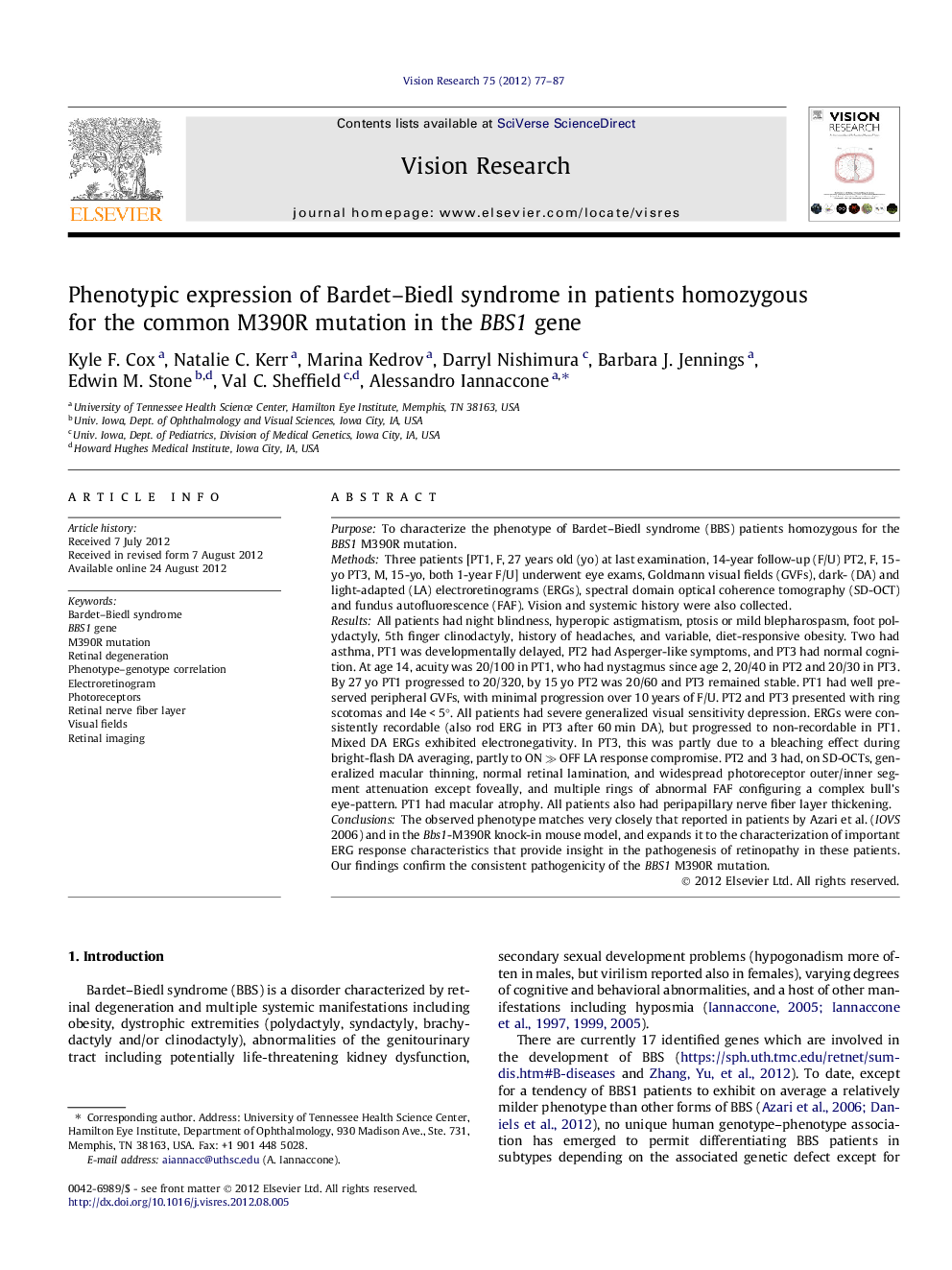| Article ID | Journal | Published Year | Pages | File Type |
|---|---|---|---|---|
| 4033873 | Vision Research | 2012 | 11 Pages |
PurposeTo characterize the phenotype of Bardet–Biedl syndrome (BBS) patients homozygous for the BBS1 M390R mutation.MethodsThree patients [PT1, F, 27 years old (yo) at last examination, 14-year follow-up (F/U) PT2, F, 15-yo PT3, M, 15-yo, both 1-year F/U] underwent eye exams, Goldmann visual fields (GVFs), dark- (DA) and light-adapted (LA) electroretinograms (ERGs), spectral domain optical coherence tomography (SD-OCT) and fundus autofluorescence (FAF). Vision and systemic history were also collected.ResultsAll patients had night blindness, hyperopic astigmatism, ptosis or mild blepharospasm, foot polydactyly, 5th finger clinodactyly, history of headaches, and variable, diet-responsive obesity. Two had asthma, PT1 was developmentally delayed, PT2 had Asperger-like symptoms, and PT3 had normal cognition. At age 14, acuity was 20/100 in PT1, who had nystagmus since age 2, 20/40 in PT2 and 20/30 in PT3. By 27 yo PT1 progressed to 20/320, by 15 yo PT2 was 20/60 and PT3 remained stable. PT1 had well preserved peripheral GVFs, with minimal progression over 10 years of F/U. PT2 and PT3 presented with ring scotomas and I4e < 5°. All patients had severe generalized visual sensitivity depression. ERGs were consistently recordable (also rod ERG in PT3 after 60 min DA), but progressed to non-recordable in PT1. Mixed DA ERGs exhibited electronegativity. In PT3, this was partly due to a bleaching effect during bright-flash DA averaging, partly to ON ≫ OFF LA response compromise. PT2 and 3 had, on SD-OCTs, generalized macular thinning, normal retinal lamination, and widespread photoreceptor outer/inner segment attenuation except foveally, and multiple rings of abnormal FAF configuring a complex bull’s eye-pattern. PT1 had macular atrophy. All patients also had peripapillary nerve fiber layer thickening.ConclusionsThe observed phenotype matches very closely that reported in patients by Azari et al. (IOVS 2006) and in the Bbs1-M390R knock-in mouse model, and expands it to the characterization of important ERG response characteristics that provide insight in the pathogenesis of retinopathy in these patients. Our findings confirm the consistent pathogenicity of the BBS1 M390R mutation.
► Systemic and ophthalmic phenotype of subjects with common M390R homozygous mutation of BBS1 gene. ► Describe clinical and functional ocular findings using fundus photos, visual fields, ERGs, and macular/disk SD-OCTs. ► Vasculature attenuation, macular and RPE atrophy, and bull’s eye maculopathy was seen in all cases. ► Electronegative ERGs with ON ≫ OFF bipolar cell compromise characterize affected patients. ► Retinal nerve fiber layer thickening was observed and is a novel finding.
